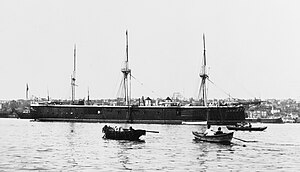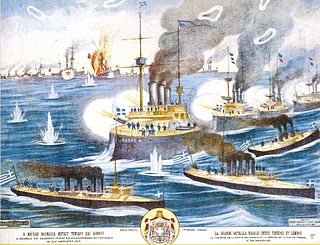
The Naval Battle of Lemnos, fought on 18 January [O.S. 5 January] 1913, was a naval battle during the First Balkan War, in which the Greeks defeated the second and last attempt of the Ottoman Empire to break the Greek naval blockade of the Dardanelles and reclaim supremacy over the Aegean Sea. This, the final naval battle of the First Balkan War, forced the Ottoman Navy to retreat to its base within the Dardanelles, from which it did not venture for the rest of the war, thus ensuring the dominion of the Aegean Sea and the Aegean islands by Greece.
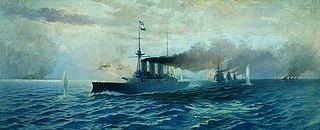
The Battle of Elli or the Battle of the Dardanelles took place near the mouth of the Dardanelles on 16 December [O.S. 3 December] 1912 as part of the First Balkan War between the fleets of the Kingdom of Greece and the Ottoman Empire. It was the largest sea battle of the Balkan Wars.

SMS Kurfürst Friedrich Wilhelm was one of the first ocean-going battleships of the German Kaiserliche Marine. The ship was named for Prince-elector Friedrich Wilhelm, 17th-century Duke of Prussia and Margrave of Brandenburg. She was the fourth pre-dreadnought of the Brandenburg class, along with her sister ships Brandenburg, Weissenburg, and Wörth. She was laid down in 1890 in the Imperial Dockyard in Wilhelmshaven, launched in 1891, and completed in 1893. The Brandenburg-class battleships carried six large-caliber guns in three twin turrets, as opposed to four guns in two turrets, as was the standard in other navies.
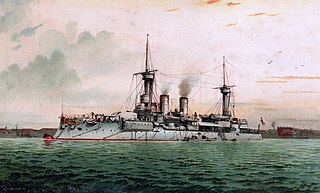
SMS Weissenburg was one of the first ocean-going battleships of the Imperial German Navy. She was the third pre-dreadnought of the Brandenburg class, which also included her sister ships Brandenburg, Wörth, and Kurfürst Friedrich Wilhelm. Weissenburg was laid down in 1890 in the AG Vulcan dockyard in Stettin, launched in 1891, and completed in 1894. The Brandenburg-class battleships were unique for their era in that they carried six large-caliber guns in three twin turrets, as opposed to four guns in two turrets, as was the standard in other navies.

Spetsai was a Greek ironclad battleship of the Hydra class that served in the Royal Hellenic Navy from 1890 until 1920. She was named after the Saronic Gulf island of Spetses, which played a key role in the war at sea during the Greek War of Independence. Spetsai she was ordered in 1885 in response to a crisis in the Balkans and Ottoman naval expansion. The ship was launched in 1889 and delivered to Greece by 1902. She was armed with a main battery of three 10.8 inches guns and five 5.9 inches guns, and had a top speed of 17 knots.

Hydra was an ironclad warship of the Greek Navy, named for Hydra, one of the Saronic Gulf islands which played a key role in the war at sea during the Greek War of Independence. The lead ship of her class of ironclads, she was ordered in 1885 in response to a crisis in the Balkans and Ottoman naval expansion. The ship was launched in 1889 and delivered to Greece by 1892. She was armed with a main battery of three 10.8 in (270 mm) guns and five 5.9 in (150 mm) guns, and had a top speed of 17 kn.

Psara was a steel-built ironclad warship named for one of the Aegean Sea islands that played a key role in the war at sea during the Greek War of Independence. The final vessel of the Hydra class, she was ordered in 1885 in response to a crisis in the Balkans and Ottoman naval expansion. The ship was launched in 1889 and delivered to Greece by 1902. She was armed with a main battery of three 10.8 in (270 mm) guns and five 5.9 in (150 mm) guns, and had a top speed of 17 kn.

The Brandenburg class consisted of four pre-dreadnought battleships built for the German Kaiserliche Marine, the first modern battleships of the fleet. The four ships of the class—Brandenburg, Wörth, Weissenburg, and Kurfürst Friedrich Wilhelm—were the first ocean-going capital ships built for the German fleet in nearly two decades, owing to reluctance in the Reichstag to fund large projects. They followed a series of small coastal defense ships, and though in retrospect they anticipated the buildup that created the High Seas Fleet, they were ordered as part of a construction program that reflected the strategic and tactical confusion that affected many navies in the 1880s. The design process that resulted in the Brandenburg class was very lengthy, with proposals that ranged from outdated casemate ships to versions with two twin-gun turrets placed side by side. The designers ultimately settled on ships that were armed with an unusual main battery of six 28 cm (11 in) guns at a time when all foreign battleships were built with four or fewer heavy guns.

Berk-i Satvet was a torpedo cruiser of the Ottoman Navy, the second and final member of the Peyk-i Şevket class. She was built by the Germaniawerft shipyard in Germany in 1906–1907, and was delivered to the Ottoman Navy in November 1907. The ship's primary armament consisted of three 450 mm (17.7 in) torpedo tubes and a pair of 105 mm (4.1 in) guns, and she was capable of a top speed of 21 knots. The ship's early career was uneventful; the Italo-Turkish War of 1911–1912 passed without any action of the Ottoman fleet. Berk-i Satvet saw action during the Balkan Wars of 1912–1913 in the Aegean and Black Seas, against Greek and Bulgarian opponents, respectively.

Asar-i Tevfik was an ironclad warship of the Ottoman Navy built in the 1860s, the only member of her class. She was built as part of a major expansion program for the Ottoman fleet in the 1860s following the Crimean War. Asar-i Tevfik was a 4,600-metric-ton barbette ship armed with a main battery of eight 220-millimeter (8.7 in) guns in a central battery. In 1903–1906, the ship was extensively rebuilt in Germany and a new battery of 150 mm (5.9 in) and 120 mm (4.7 in) quick-firing guns replaced the older weapons.
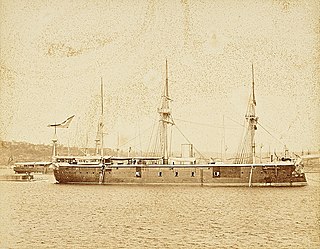
Hamidiye was a unique ironclad warship built for the Ottoman Navy in the 1870s, the last vessel of the type completed for the Ottomans. She was a central battery ship, mounting most of her armament in a central casemate. The ship, built by the Ottoman Imperial Arsenal took nearly twenty years to complete; she was laid down in December 1874, launched in 1885, and completed in 1894. Due to her lengthy construction period, she was already obsolete by the time she was launched. Her poor handling and low quality armor contributed to a short career, spent almost entirely as a stationary training ship. She was briefly activated in 1897 during the Greco-Turkish War, but she was already in bad condition just three years after she entered service, as was the rest of the ancient Ottoman fleet. The Ottomans embarked on a reconstruction program after the incident humiliated the government, but Hamidiye was in too poor a state by 1903 to warrant rebuilding, and she was accordingly decommissioned that year, placed for sale in 1909, and sold to ship breakers in 1913.

Necm-i Şevket was the second of two Asar-i Şevket-class central battery ships built for the Ottoman Navy in the 1860s. Originally ordered by the Khedivate of Egypt but confiscated by the Ottoman Empire while under construction, the vessel was initially named Muzaffer. The ship was laid down at the French Forges et Chantiers de la Gironde shipyard in 1867, was launched in 1868, and was commissioned into the Ottoman fleet in March 1870. Asar-i Şevket was armed with a battery of four 178 mm (7 in) Armstrong guns in a central casemate and one 229 mm (9 in) Armstrong gun in a revolving barbette.

Iclaliye ("Glorious") was a unique ironclad warship built for the Ottoman Navy in the late 1860s and early 1870s. She was ordered from the Austro-Hungarian shipyard Stabilimento Tecnico Triestino, was laid down in May 1868, and was completed in February 1871. The design for Iclaliye was based on the earlier Asar-i Şevket-class ironclads built in France, though she carried a slightly more powerful armament consisting of two 228 mm (9 in) Armstrong guns and three 178 mm (7 in) Armstrong guns. During the Russo-Turkish War she supported Ottoman forces fighting in the Caucasus. She spent most of the rest her career out of service, as the Ottoman Navy was allowed to languish. In 1912, the Navy activated the ancient Iclaliye to help provide artillery support to the forces defending Constantinople. She served in subsidiary roles, including as a training ship and a barracks ship, until 1928 when she was decommissioned and broken up.

Aziziye, named for Sultan Abdülaziz, was the second of four Osmaniye-class ironclad warships built for the Ottoman Navy in the 1860s. The ship was laid down at the Robert Napier and Sons shipyard in 1863, was launched in January 1865 and was commissioned in August that year. A broadside ironclad, Aziziye carried a battery of fourteen 203 mm (8 in) RML Armstrong guns and ten 36-pounder Armstrongs in a traditional broadside arrangement, with a single 229 mm (9 in) RML as a chase gun. Among the more powerful of Ottoman ironclads, the Navy decided to keep the ship safely in the Mediterranean Sea during the Russo-Turkish War of 1877–1878 to preserve the vessel. She spent the 1880s out of service, though she was heavily rebuilt in the early 1890s and converted into a more modern barbette ship. She was nevertheless in poor condition by the time of the Greco-Turkish War in 1897, as a result saw no action, and was disarmed after the war. She saw no further active service, being used briefly as a barracks ship from 1904 to 1909. In 1923, she was sold to ship breakers and dismantled.

Yadigar-i Millet, originally built as SMS S166, was one of the four S138-class torpedo boats built for the German Imperial Navy, but was purchased by the Ottoman Navy National Support Association for the Ottoman Navy.
Nümune-i Hamiyet, originally built as SMS S167, was one of the four S138-class torpedo boats built for the German Imperial Navy, but was purchased for the Ottoman Navy during construction.
Gayret-i Vataniye originally built as SMS S168, was one of the four S138-class torpedo boats built for the German Imperial Navy, but was purchased for the Ottoman Navy during construction.
Basra was one of the four Durandal-class destroyers purchased by the Ottoman Empire from France in 1907. The ship served in the Ottoman Navy during the Italo-Turkish War, the Balkan Wars and World War I.
Taşoz was one of the four Durandal-class destroyers purchased by the Ottoman Empire from France in 1907. The ship served in the Ottoman Navy during the Italo-Turkish War, the Balkan Wars and World War I.
